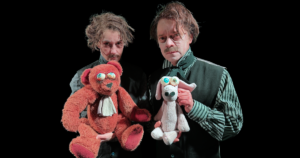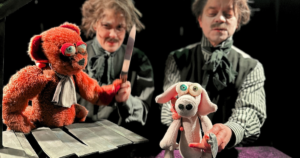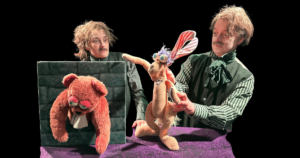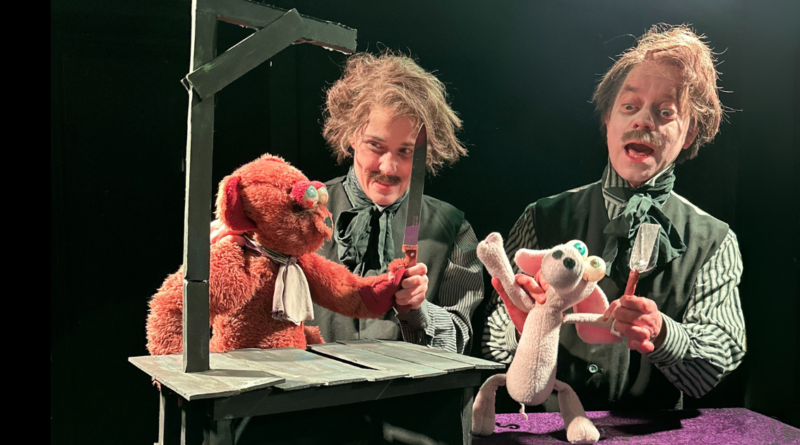Demented delight awaits in “The House at Poe Corner”
In A.A. Milne’s Winnie-the-Pooh, Pooh asks his friend, “Rabbit, is that you?” Rabbit replies, “Let’s pretend it isn’t . . . and see what happens.”

I thought about that reply – which is both a snarky aside and an invocation of the power of imagination – when I saw the tonally twisted The House at Poe Corner the other night. The wickedly whimsical creation of Michael O’Brien and Eric Woolfe, it is playing at the Red Sandcastle Theatre in what Eldritch Theatre calls a “tenth-deathiversary” celebration.
Winnie-the Pooh, Rabbit, Piglet and Eeyore – is that you?
Let’s pretend it isn’t.
Let’s pretend that characters similar to them – named Poe Bear, Jack Hare, Cutlet and Gloomhoof – exist in an alternate universe. In that universe, they live not in the idyllic Hundred Acre Wood, but in the ”ghoul-haunted woodland of Weir”. This foreboding setting of Edgar Allan Poe’s grief-inflected poem Ulalume has not been a happy place since the disappearance of its owner or overseer Mr. Usher, who has been imported from Poe’s famous story The Fall of the House of Usher.
Let’s mash up the dark horror and psychological turmoil of Edgar Allen Poe with the idyllic innocence of Milne’s Winnie-the-Pooh . . . and see what happens.
And what a loopy lot does happen!
Our human narrators and guides to this atmospheric, foggy Poe-scape are the laconic, mournful and slow molasses-voiced Mr. Edgar (Eric Woolfe) and the more excitable (though no less dolorous) Mr. Allen (Mairi Babb). This delightful duo spin a solemnly serious spell from spooky-silly “Grim Warbles” by Cathy Nosaty, sleight-of-hand magic, and intense narration that is punctuated by dry, winking Rabbit-like asides.

With these ingredients, they proceed to tell – or rather, act out with puppets – a series of tales about Milne’s characters . . . except they’ve been refracted through a Poe-tent prism of horror into a woodland of misfit toys. Poe Bear is a lankier, somehow dangerous looking teddy bear – minus the Disney belly and colourful shirt. Cutlet is a small, all-white, oddly angular piglike toy. And diverse transmogrifications have re-shaped the other characters (none quite as horrifyingly as Kanga).
The tales are twisted versions of Poe and Pooh tales, with my personal favorite being “The Telltale Tail”. At their core, the characters act like their 100 Acre Wood incarnations. But because of the horror-steeped setting, their attitudes and actions are exponentially more extreme. So Pooh Bear’s innocent wisdom and childlike wonder becomes Poe Bear’s hubristic self-confidence and mockery of what he doesn’t believe. And Piglet’s timid anxiety becomes Cutlet’s paroxysmal fear of the dreaded Blunderbeast.
And several of the characters’ predilections, when magnified, become comically homicidal (call them comicidal) tendencies. Eldritch Theatre’s trademark red fabric – aka puppet blood – flies with abandon. The body count – and the frequent un-killing of the dead, so they can kill or be killed in the next tale – reminded me of The Simpsons’ The Itchy and Scratchy Show.
Woolfe and Babb’s performances are brilliantly macabre, and their puppetry is remarkable. So skilfully and surprisingly do they contort and manipulate the characters that at moments, you believe these toys are alive (and then dead, and then alive again). In one of the best scenes of puppetry I’ve ever seen, the puppets fight their way through an impossibly stiff wind that seems to be taking their feet out from under them.
The biggest tale of the most horrific foe – the Blunderbeast, whom Poe Bear belligerently insists is not real – is saved for the finale of the show, which embodies exquisitely the fusion of the seemingly disparate sensibilities of Poe and Pooh.

In Milne’s original Pooh tales, the characters learn the tiniest of lessons, but don’t really grow. The stories argue for staying where you are, as you are in a world of childhood, where you can find wonder, joy and meaning in the simplest of things. Meanwhile, the OG Edgar Allan Poe stories feature adult characters with psychological complexities and obsessions that colour their perceptions, prevent them from finding joy or meaning . . . and ultimately cause their downfall.
Under Poe pressures, these Pooh characters stay just as they are, albeit dialled up to a murderous 11. By staying the same, they cause their own downfall and death . . . and yet still find a way to continue to be the same.
A gothic carnival show that parodies, entertains and even affirms, The House at Poe Corner is a demented and dexterous delight with surprising depth.
The House at Poe Corner runs until April 21 at The Red Sandcastle Theatre. Click here to reserve tickets.
© Scott Sneddon, SesayArts Magazine, 2024
About The Author
Scott Sneddon
Scott Sneddon is Senior Editor on SesayArts Magazine, where he is also a critic and contributor.
Visit About Us > Meet the Team to read Scott’s full bio …



